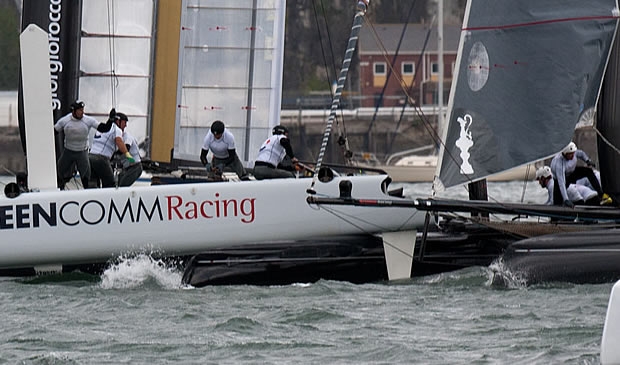
Another drama-laden Sunday
Sundays at the America’s Cup World Series in Plymouth and it would seem a good idea to say your prayers before going racing. Even this morning, the day was lining up as one of terror with the four AC45s in Millbay Dock romping around on their moorings while there were some alarming attempts to crane the wingsails on to the catamaran platforms.
Once out on to Plymouth Sound in a wind that had veered even further around to the North, blowing off the Hoe at times, there were bombs of breeze gusting up to 25 knots or more, bringing with them huge shifts. Capsizes, it seemed, would be inevitable.
First up before the race had even started was Loick Peyron and Energy Team...Peyron having previously been proud of his 30 year record in multihull racing that had never previously involved a capsize. Team Korea was at a standstill as Peyron's Energy Team were approaching them from astern when a big gust hit causing Team Korea to drift backwards. Peyron later said that in retrospect he should have tacked, but in the end he bore away causing the weather hull to fly high into the air and, et voila, they were over. However he was pleased they managed to right their boat: the Energy Team RIB pulled their wing into the wind from where they were able to water start, much like a windsurfer.
“I think we are buying the drinks for Energy Team for a good few weeks,” said Draper.
While Team Korea came away unscathed, Energy Team went on to start the race impressively coming home in sixth place, just 4 minutes 22 seconds after the winner.
More drama was to come prior to the start gun when there was an impressive collision, initially with Aleph ramming Green Comm just aft of the daggerboard. Then the unfortunate Spanish boat was struck by Artemis Racing.
As Artemis Racing skipper Terry Hutchinson described it: “Green Comm ended up on port tack in front of us and started backing towards us at about the same time as we got a really big puff. At that point we were going to sail straight up their transom, so I pulled the bow down and tried to go behind them and we couldn’t make it.”
Artemis’ starboard bow collided with Green Comm’s port transom, the knife-like profile bow on the Swedish catamaran, shovelling up the Spanish cat's port hull intriguingly leaving their rudder hooked on the inboard side of Artemis' starboard hull. Somehow Green Comm managed to extricate themselves, but in the process their skipper Vasilij Zbogar injured his hand. With their rudder damaged Green Comm was forced to retire from racing and Zbogar was whisked off to hospital for an X-Ray.
A still rather grogy Zbogar gave his take on what happened: “Before the start, Team New Zealand was just below and they were trying to go up, so we tried to tack, and we went head to wind and Aleph came and beat us to it, but I said let’s go with the hole, we can still race and then after that Artemis came and hit us on the back and that damaged the rudder and we weren’t able to continue.
“When we crashed with Artemis, I tried to get on their boat to lift the boat, to remove the rudder from the ropes and then I jumped on the boat and something hit me on the head and then I slipped on the rudder and fell into the water.”
Following this collision, the problems for Artemis were compounded as their damaged starboard bow had sprung a leak. “We were taking on water fairly significantly in the starboard hull and eventually it caught up with us at the last top mark,” recalled Hutchinson. “We did a bear away gybe and deployed, but you could feel the inertia of the water inside the starboard hull just drive the bow down...” And over she went, with one crewman who thought he was clever climbing on to the topsides of the starboard hull, losing his grip and falling off through the bottom panel of the wing. Nonetheless the team quickly righted their AC45 and continued racing only to be told they were out of time – the deadline for finishing, 10 minutes after the winner, had passed.
In the difficult conditions and with Artemis still licking her wounds after their pre-start collision, it was the two Oracle Racing boats and Emirates Team New Zealand that were the fastest out of the blocks with Russell Coutts leading Emirates Team New Zealand with Spithill in third around the first reaching mark.
China Team were in the mix but were unable to pull off the bear away at the first reaching mark and ended up being the second boat to capsize in this drama-laden race. Once again through fast action, their AC45 was righted and they continued racing, coming home seventh just within the time limit.
Out of the blocks we wondered where Team Korea was heading as they didn’t seem to be pointing towards the reaching mark. Chris Draper explained: “We were conscious of what happened last Sunday [when they capsized rounding the reaching mark], so we didn't want to put the boat in the tide today. We didn’t want to bear away in the gust going down the first reach. In hindsight I think that was a good decision, so we waited for that to settle and bore away to the reaching mark after that. That is where we lost touch with the first few and it was hard for us to make inroads into them. But we ended up having a great race with Bertrand [Pace, Aleph].”
While they left a carnage-strewn race course behind them, the lead trio enjoyed an excellent race despite the testing conditions. After Coutts led down the first run, Emirates Team New Zealand pulled into the lead by getting the inside berth at the first leeward gate rounding. But on the next beat the Oracle boats, once again engaged in their own private match race, did well, tacking inshore towards the Hoe and came out with Coutts retaking the lead and rounding the top mark in first again. On the next run it was Spithill’s turn to overtake and so the race continued with the three boats all jockeying for honours with Spithill eventually taking the winner’s flag just 18 seconds ahead of Emirates Team New Zealand and 32 seconds in front of Coutts.
“It was about time to be honest,” said Spithill later. “We were pretty disappointed with the match racing. We have been trying to step it up and learn as much as we can during the week and we certainly came out with the goal of trying to walk away with a result. It really showed how tight it was. We got tangled with Russ at one of the gates - as you can see we pull no punches with each other - and we got a penalty.
“We were racing, pushing. I still don’t think we are at the limit. There was about 25 knots at times. It was the puffiness and the shifty breeze that made it challenging for all the sailors. The boats can take a lot more wind. It was an incredibly exciting race track. And there were a lot of opportunities out there. We enjoyed it. You just haven’t seen that level of excitement in the past; the lead changes, even getting off the dock is pretty exciting, but that is exactly what we want to showcase to the next generation, because I think the kids of today will look at these boats and say ‘sailing’s cool and I want to be a part of it’.”
One of the reasons for Oracle Racing’s dominance in the stiff conditions is the time they have spent training in big conditions in Auckland and San Francisco. “You can sail in a lot of wind in these boats. We have sailed in a steady 30 knots in Auckland, but when you sail in a puffy shifty 24-25 knots, that is almost harder, especially downwind with the gybes and knowing when to back off,” Spithill told us.
Dean Barker quipped that on Emirates Team New Zealand they felt like the meat in an Oracle sandwich during today’s race. “It was good racing and, in that much breeze, to have three boats so close all around the course was pretty cool. We feel like we are still improving and that is the main thing. We only had one moment when it was getting a little bit hairy. There was plenty of breeze at times, but just managing the boat in those situations is one of the biggest challenges.
“The Oracle guys - clearly you can see they have done some sailing in that breeze strength and they are a bit more comfortable. Sure, you could have pushed harder today, but it was a bit about boat preservation as well. Normally the harder you push the safer you are, when you start sailing too conservatively and the apparent wind starts going further aft that is when you start nosediving, so I think if you keep pushing hard at times it is a safer way out, which is perhaps contrary to what you think.”
Russell Coutts told us that he was very happy with how the event in Plymouth had gone, the excitement adequately fever pitched. “I think it will get better. And the guys will get better at racing the boats too. Eventually you possibly won’t see as many capsizea, although we will perhaps be sailing in bigger breeze than this.”
However Coutts was less happy with the way he personally was racing. In particular he said that his team had definitely dropped off the pace in the latter stage of today’s race. “In terms of the event I couldn’t have asked for much more. The racing is fantastic. It is testing everyone, both tactically and physically. Every aspect of sailing talent is being tested – it is great.”
From here, how much time Coutts will spend on the helm is uncertain. Certainly for San Diego he is passing the stick of his AC45 over to catamaran guru Darren Bundock. “We are going to move some people around. Now we understand these boats a bit more we want to see if we can get some better combinations going, because we need to a good solid two boat program going at the end to stand any chance of winning this.”
As to the format for the America’s Cup World Series regattas, Coutts told us this remains a work in progress. “I think there is a lot we can get better, little things we will improve, like the labelling of the course and the marker boats, not on the television [but for spectators and competitors]. The marker boats that we will eventually use aren’t here yet, they are being built at the moment. And there’s the identification of those marks so that people can understand what the course is, the course boundaries, etc once we get the on-the-water signage developed. They might frame the starting boxes, for example, to make it visually clearer for the sailors and non-sailors about the layout of the course - that will be another major improvement.”
And then there’s the penalty system (read more about this here). “The whole concept with this is to make it a television event and to create close racing, so we don’t want to have rules or penalties ending a race. I just think that is wrong. If you look at other sports like rugby football, they have the advantage rule. Several years ago the game was being stop-started a lot by the referees, so they changed the rules to make the game flow more. We need to look at those things as well. We don’t want a penalty half way through a race ending a race. We want to give the penalised yacht enough of a penalty that they are behind the other boat, but still in the race. And a premature starter – they definitely need to be penalised, but really not such a big penalty that it ends the race at the start.”
Coutts echoed the sentiments of many here in Plymouth, lamenting the lack of a British team: “It is a shame there is not a British team out there racing. There should be a British team. The Brits are leading Olympic sailing in terms of their ability and top Olympic sailors are perfect candidates to come and race on these boats. It is good that the Brits are helping all the other teams, but maybe they should think about getting their own team together.”
The nearest you get to a British team is Team Korea where four of the crew on board are Brits. Impressively yesterday Chris Draper’s team neatly dispatched Artemis to end up second in the match racing to the high experienced crew of Emirates Team New Zealand.
“We are really pleased,” said Draper of Team Korea’s performance in the match racing. “With the way the format was originally, we’d always just been hoping to qualify for the match racing. The change in pre-start format to what it is now aided us a lot - generally in those we have done pretty well, but we struggled yesterday in the final when we had some pretty rough deals on the wind shifts on the entries, which made life pretty hard. Our learning curve is very very steep and we are very pleased with where we are now, but we are under no illusion that we have a ton to learn.”
The problem for the newer teams like Korea is that, with the schedule for the America’s Cup World Series, there is precious little time to train in the AC45s – hence why at this stage the big three who have had most time in the new AC one design catamaran are that much better at racing them, making Team Korea’s result here in Plymouth all the more praise-worthy.
“We are hoping that we are going to be able to find a good training window at some point and really get a chance to work hard,” Draper told us. “It might not come for two or four months or until the end of the season. Then there are other boats we can go and sail to improve our skills and get better as a team. That is the sort of things we’ll do. That is on hold at the minute, but fingers crossed we’ll be in a position to do that in the New Year.”
So generally the America’s Cup World Series has been well received in Plymouth with apparently 115,000 people watching from the natural amphitheatre viewing spot on the Hoe here. But as yet there is no word about the event returning to Plymouth.
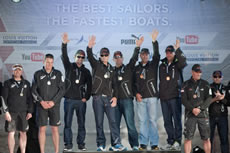 |
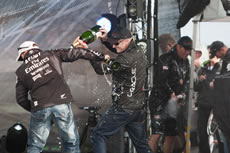 |
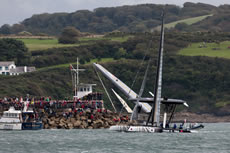 |
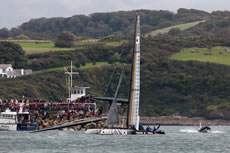 |
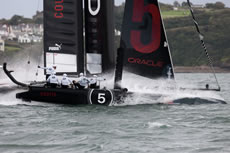 |
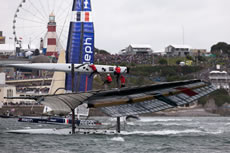 |
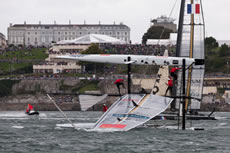 |
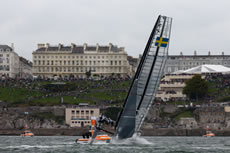 |
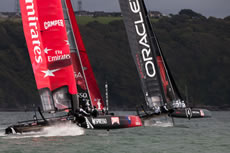 |
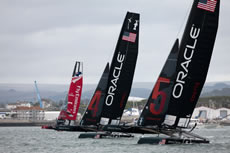 |
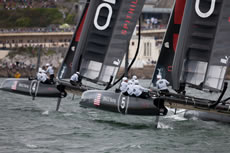 |
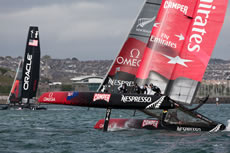 |
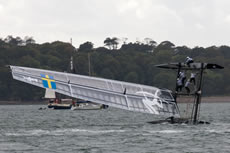 |
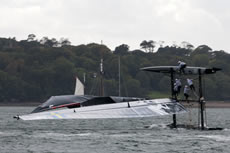 |
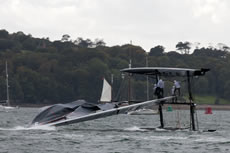 |
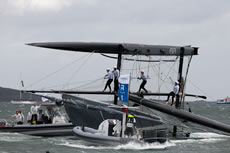 |
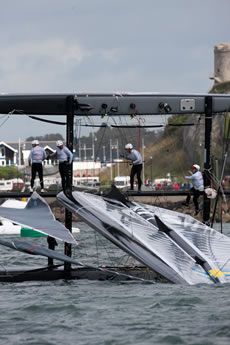 |
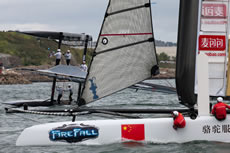 |
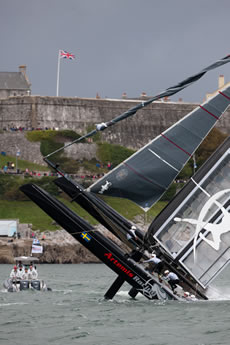 |
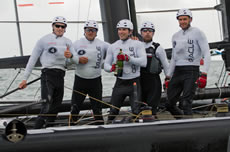 |








Latest Comments
Add a comment - Members log in